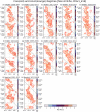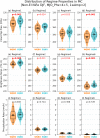QBO deepens MJO convection
- PMID: 37429838
- PMCID: PMC10333186
- DOI: 10.1038/s41467-023-39465-7
QBO deepens MJO convection
Abstract
The underlying mechanism that couples the Quasi-Biennial Oscillation (QBO) and the Madden-Julian oscillation (MJO) has remained elusive, challenging our understanding of both phenomena. A popular hypothesis about the QBO-MJO connection is that the vertical extent of MJO convection is strongly modulated by the QBO. However, this hypothesis has not been verified observationally. Here we show that the cloud-top pressure and brightness temperature of deep convection and anvil clouds are systematically lower in the easterly QBO (EQBO) winters than in the westerly QBO (WQBO) winters, indicating that the vertical growth of deep convective systems within MJO envelopes is facilitated by the EQBO mean state. Moreover, the deeper clouds during EQBO winters are more effective at reducing longwave radiation escaping to space and thereby enhancing longwave cloud-radiative feedback within MJO envelopes. Our results provide robust observational evidence of the enhanced MJO activity during EQBO winters by mean state changes induced by the QBO.
© 2023. The Author(s).
Conflict of interest statement
The authors declare no competing interests.
Figures









References
-
- Klotzbach PJ. The Madden–Julian Oscillation’s impacts on worldwide tropical cyclone activity. J. Clim. 2014;27:2317–2330. doi: 10.1175/JCLI-D-13-00483.1. - DOI
-
- Wheeler, M. C. & McBride, J. L. Australian-Indonesian monsoon. in Intraseasonal Variability in the Atmosphere-Ocean Climate System 125–173 10.1007/3-540-27250-X_5 (Springer Berlin Heidelberg, 2005).
Grants and funding
- 80NSSC17K0227/National Aeronautics and Space Administration (NASA)
- DE-SC0016223/DOE | SC | Biological and Environmental Research (BER)
- NA18OAR4310300/United States Department of Commerce | NOAA | Climate Program Office (NOAA Climate Program Office)
- KMI2021-01210/Korea Meteorological Administration (KMA)
- NRF-2021H1D3A2A01039352/National Research Foundation of Korea (NRF)
LinkOut - more resources
Full Text Sources

